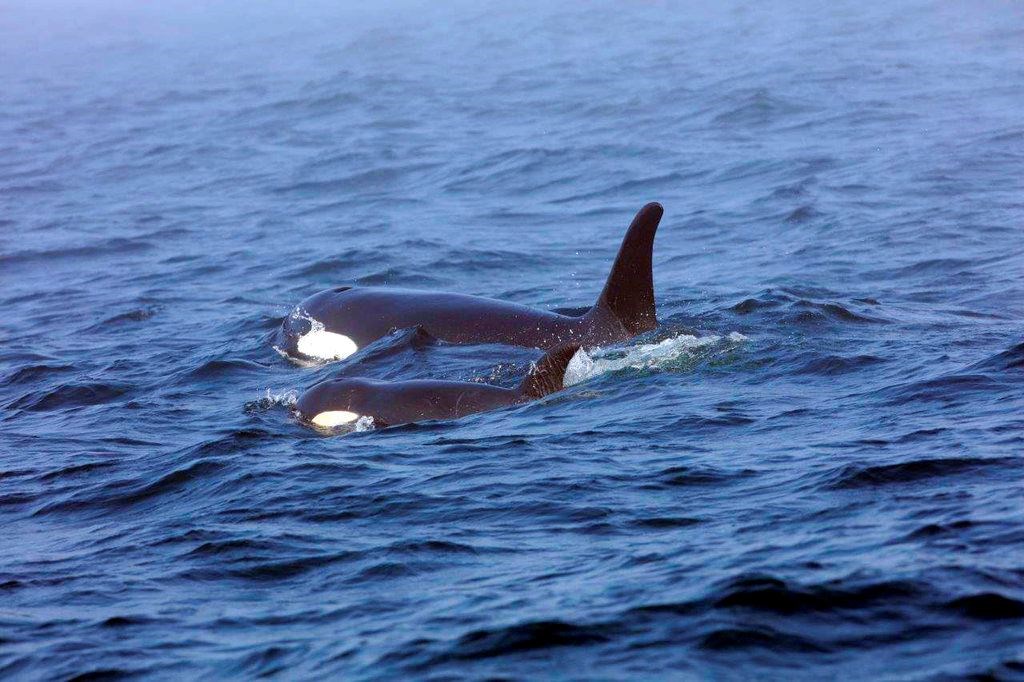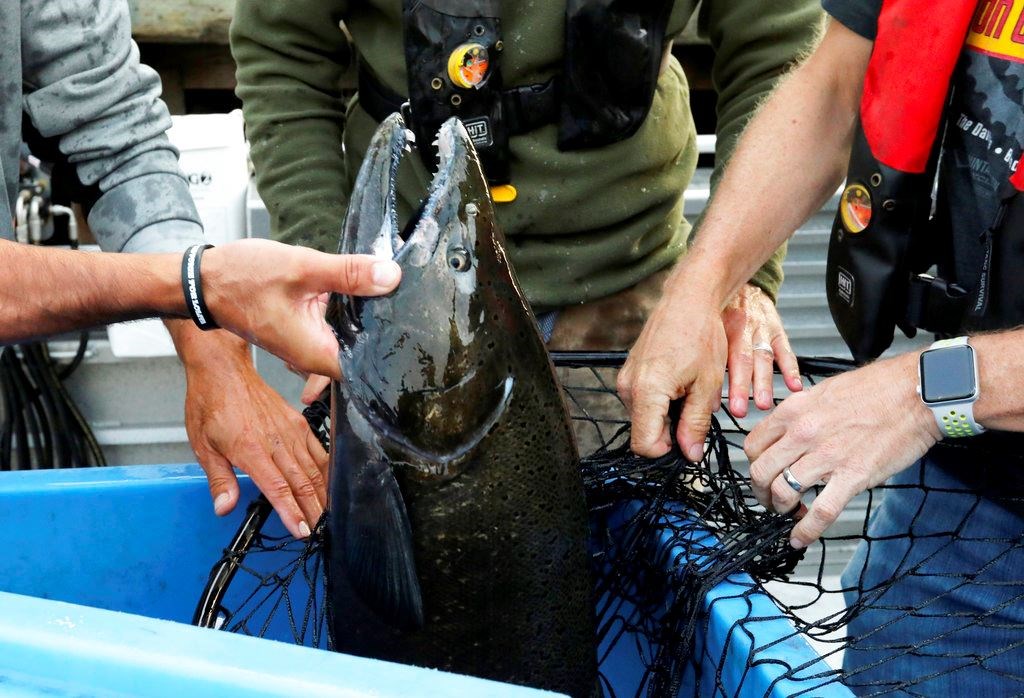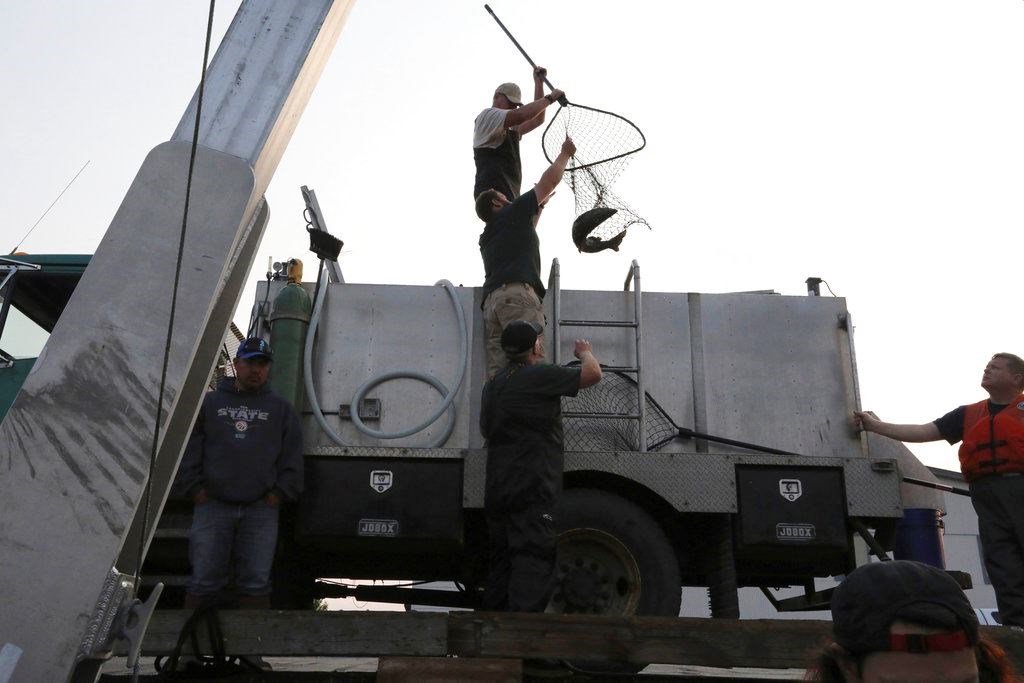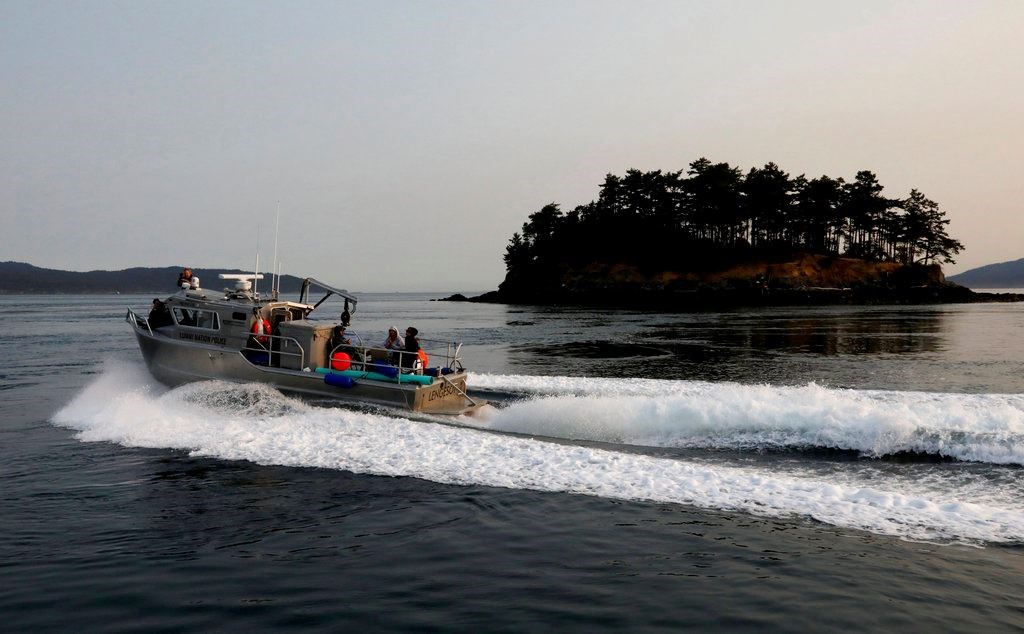AUGUST 10, 2018 - FALSE BAY, Wash. (AP) — Teams taking drastic measures to save a young, ailing killer whale loaded up two boats with fat live salmon as the sun rose Friday and rushed to waters off Washington state's San Juan Island, preparing if needed to test-feed the critically endangered orca a day after injecting it with medicine.
 In this Tuesday, Aug. 7, 2018, Southern Resident killer whale J50 and her mother, J16, swim off the west coast of Vancouver Island near Port Renfrew, B.C. J50 is the sick whale that a team of experts are hoping to save by giving her antibiotics or feeding her live salmon at sea. The experts now have authorization to intervene with medical treatment in both U.S. and Canadian waters once the critically endangered orca shows up again in the inland waters of the Pacific Northwest.Brian Gisborne/Fisheries and Oceans Canada via APBy early afternoon, it appeared the 3½-year-old female orca called J50 was too far north in Canadian waters and any trial feeding effort would not happen, Brad Hanson, a wildlife biologist with the National Oceanic and Atmospheric Administration who is leading response efforts in the field, told reporters out on the water.
In this Tuesday, Aug. 7, 2018, Southern Resident killer whale J50 and her mother, J16, swim off the west coast of Vancouver Island near Port Renfrew, B.C. J50 is the sick whale that a team of experts are hoping to save by giving her antibiotics or feeding her live salmon at sea. The experts now have authorization to intervene with medical treatment in both U.S. and Canadian waters once the critically endangered orca shows up again in the inland waters of the Pacific Northwest.Brian Gisborne/Fisheries and Oceans Canada via APBy early afternoon, it appeared the 3½-year-old female orca called J50 was too far north in Canadian waters and any trial feeding effort would not happen, Brad Hanson, a wildlife biologist with the National Oceanic and Atmospheric Administration who is leading response efforts in the field, told reporters out on the water.
For now, the unprecedented attempt to feed live salmon to a free-swimming killer whale would have to wait.
The team led by the U.S. agency lacks a permit to feed the whale, which is emaciated and possibly suffering an infection, in Canadian waters, though it had one for medical treatment. NOAA would apply for the feeding permit if conditions are right, said Lynne Barre, NOAA Fisheries' recovery coordinator for the whales.
 Lummi tribal members and Washington Department of Fish & Wildlife untangle a chinook salmon from a net used to transfer it to the King County Research Vessel SoundGuardian in Bellingham, Wash., Friday, Aug. 10, 2018. The salmon are intended to feed an ailing young orca, J50.Alan Berner/The Seattle Times via AP, PoolThe agency wants to see whether it can deliver medication to the whale through live Chinook salmon but first needs to test whether the orca will take its preferred food source.
Lummi tribal members and Washington Department of Fish & Wildlife untangle a chinook salmon from a net used to transfer it to the King County Research Vessel SoundGuardian in Bellingham, Wash., Friday, Aug. 10, 2018. The salmon are intended to feed an ailing young orca, J50.Alan Berner/The Seattle Times via AP, PoolThe agency wants to see whether it can deliver medication to the whale through live Chinook salmon but first needs to test whether the orca will take its preferred food source.
With the whale far away and a bin full of salmon pulled that morning from a state hatchery, crews did a practice run to work out the logistics of feeding live fish to a whale while staying ahead of it in a boat. One by one, crews aboard a boat belonging to the Lummi Nation, an American Indian tribe, sent the plump salmon into a turquoise tube and then into the water.
Researchers with the Whale Sanctuary Project practiced taking samples of fish scales so they can later genetically track whether the whale consumed that fish. A King County research vessel drove alongside, also carrying fish, to provide support.
 Chinook salmon from the Marblemount hatchery on the Skagit River are loaded onto the King County Research Vessel SoundGuardian at the dock in Bellingham, Wash., Friday, Aug., 10, 2018. The salmon are intended to feed ailing killer whale in a rare effort to save her.Alan Berner/The Seattle Times via AP, PoolThe orca was given a dose of antibiotics from a dart Thursday, and Marty Haulena, head veterinarian at Vancouver Aquarium, who got a close look at J50. He said the whale is incredibly skinny but was swimming well and there were no obvious signs of abnormality with her skin. It wasn't clear whether she had been eating.
Chinook salmon from the Marblemount hatchery on the Skagit River are loaded onto the King County Research Vessel SoundGuardian at the dock in Bellingham, Wash., Friday, Aug., 10, 2018. The salmon are intended to feed ailing killer whale in a rare effort to save her.Alan Berner/The Seattle Times via AP, PoolThe orca was given a dose of antibiotics from a dart Thursday, and Marty Haulena, head veterinarian at Vancouver Aquarium, who got a close look at J50. He said the whale is incredibly skinny but was swimming well and there were no obvious signs of abnormality with her skin. It wasn't clear whether she had been eating.
"I do stress this is a very thin whale," Haulena said, noting that others in the same condition have not survived.
J50 is breathing normally, taking deep dives and keeping up with her group, so respiratory disease is not as high of a concern, he said. He and others followed the whale on the water for about six hours Thursday and got a breath sample to analyze whether she might have bacteria or fungus in her airway.
 The Lummi police boat heads to the west side of San Juan Island in an attempt to feet chinook salmon to an ailing young orca, J50, seen from the King County Research Vessel SoundGardian, Friday, Aug. 10, 2018. Teams of whale experts raced out to sea Thursday to help an ailing young killer whale, but they don't plan to intervene to help a mother orca in the same critically endangered pod that has been pushing the body of her dead calf for more than two weeks.Alan Berner/The Seattle Times via AP, PoolSheila Thornton, lead killer whale scientist with Fisheries Oceans Canada, said the whale looks more like a 2-year-old though it has always been small for her age. She is deteriorating, and scientists are not seeing improvements in a loss of tissue behind her head, Thornton said.
The Lummi police boat heads to the west side of San Juan Island in an attempt to feet chinook salmon to an ailing young orca, J50, seen from the King County Research Vessel SoundGardian, Friday, Aug. 10, 2018. Teams of whale experts raced out to sea Thursday to help an ailing young killer whale, but they don't plan to intervene to help a mother orca in the same critically endangered pod that has been pushing the body of her dead calf for more than two weeks.Alan Berner/The Seattle Times via AP, PoolSheila Thornton, lead killer whale scientist with Fisheries Oceans Canada, said the whale looks more like a 2-year-old though it has always been small for her age. She is deteriorating, and scientists are not seeing improvements in a loss of tissue behind her head, Thornton said.
The young whale is one of just 75 of the fish-eating orcas that frequent the inland waters of Washington state. There hasn't been a successful birth since 2015. Losing J50 also would mean losing her reproductive potential, Hanson said.
"That's what this is really all about. The future of the population," the NOAA biologist said.
The whales face nutritional stress over a lack of Chinook salmon as well as threats from toxic contamination and vessel noise and disturbances.
Another female orca in the same pod has triggered an international outpouring as she clings to the body of her calf that died more than two weeks ago. Scientists are worried about her and will watch her but don't have plans to help her or remove the calf. She was last seen Thursday still carrying the body.
The last time scientists rescued a killer whale in the region was in 2002, when they rehabilitated an orca known as Springer who was found alone. She returned to her family of whales in Canada later that year and was seen with her calf in 2013.
Page created on 8/11/2018 12:42:41 AM
Last edited 8/11/2018 12:55:57 AM
